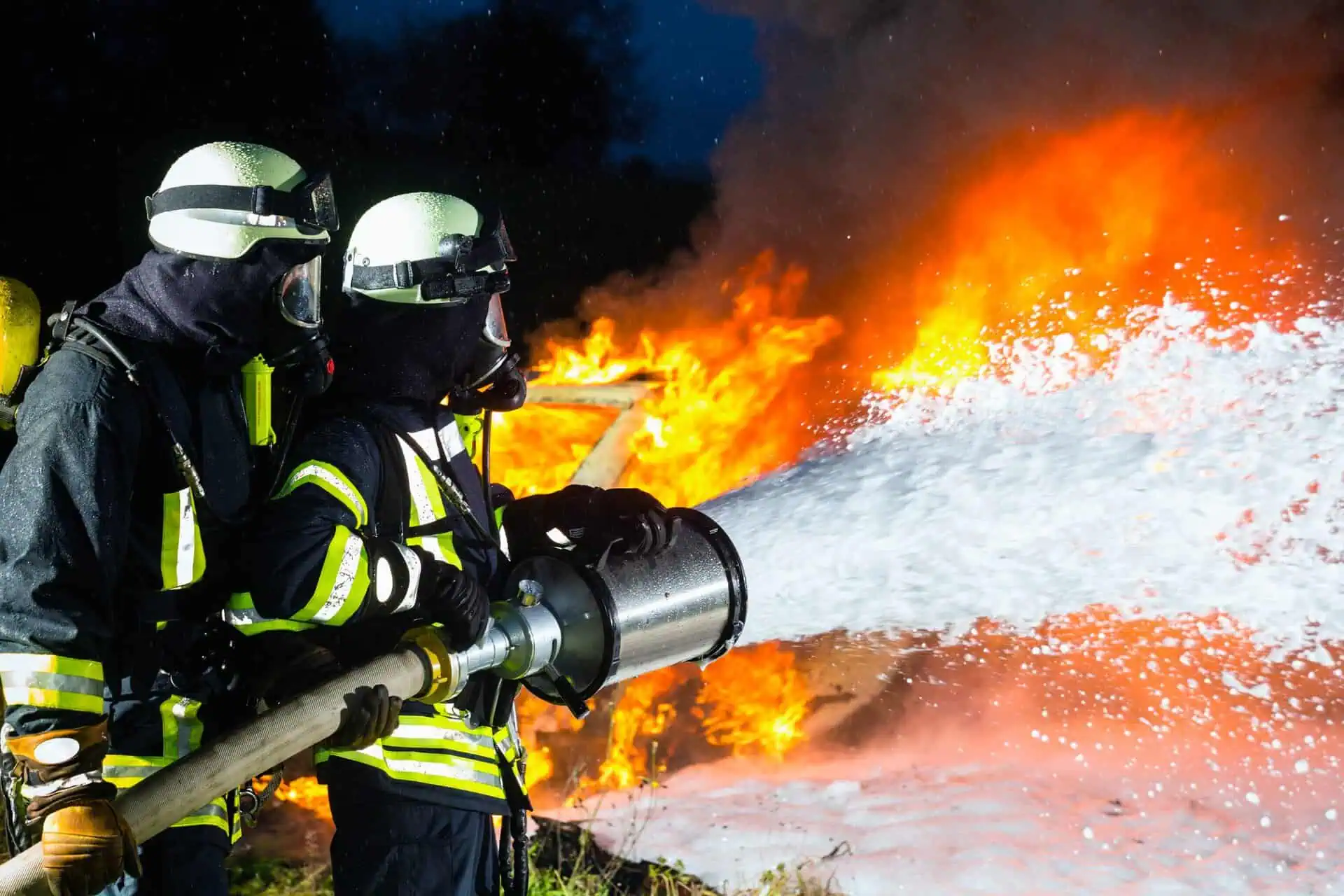FAQ: Is AFFF Firefighting Foam Toxic?
- Last Updated: June 12th, 2025

Attorney Jessica Paluch-Hoerman, founder of TruLaw, has over 28 years of experience as a personal injury and mass tort attorney, and previously worked as an international tax attorney at Deloitte. Jessie collaborates with attorneys nationwide — enabling her to share reliable, up-to-date legal information with our readers.
Legally Reviewed
This article has been written and reviewed for legal accuracy and clarity by the team of writers and legal experts at TruLaw and is as accurate as possible. This content should not be taken as legal advice from an attorney. If you would like to learn more about our owner and experienced injury lawyer, Jessie Paluch, you can do so here.
Fact-Checked
TruLaw does everything possible to make sure the information in this article is up to date and accurate. If you need specific legal advice about your case, contact us by using the chat on the bottom of this page. This article should not be taken as advice from an attorney.
Key takeaways:
- The risks associated with PFAS in firefighting gear and the necessity for transparency about PFAS content in their equipment are critical for protecting both firefighters and the ecosystem.
- Major manufacturers such as 3M and DuPont have agreed to settlements over AFFF lawsuits for allegedly producing and selling firefighting foam with dangerous PFAS chemicals, aware of the health risks but failing to adequately warn users.
- PFAS chemicals in AFFF are highly persistent environmental contaminants, capable of traveling through water and air, and bioaccumulating in humans and animals with nearly 700 military sites detecting contamination.
Is AFFF Firefighting Foam Toxic?
Question: Is AFFF firefighting foam toxic?
Answer: AFFF firefighting foam has been found to be toxic according to studies conducted by the Department of Defense since the 1970s.
These foams contain ‘forever chemicals’ that have a long-lasting environmental impact and pose significant health risks.
Firefighters, military personnel, and airport workers across the United States are filing lawsuits against major manufacturers of aqueous film-forming foam (AFFF) after developing serious health conditions from exposure.
Major manufacturers such as 3M, DuPont, and Tyco Fire Products are facing legal action for allegedly producing and selling firefighting foam containing dangerous PFAS chemicals while knowing the potential health risks, yet failing to warn users adequately.
On this page, we’ll discuss this question in further depth, toxic effects of PFAS in AFFF firefighting foam, cancer risks associated with AFFF exposure, and much more.
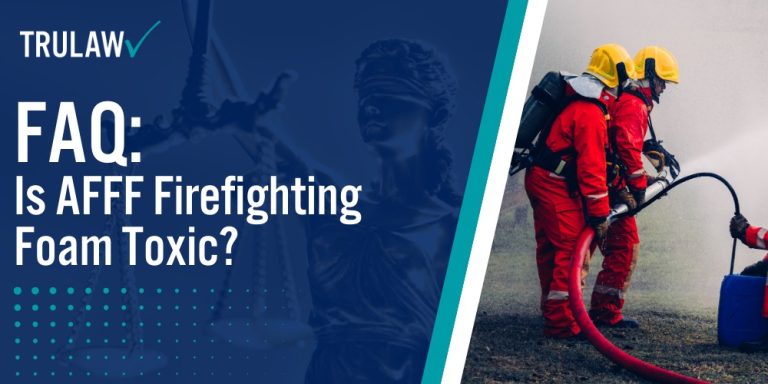
Attorneys Investigating AFFF and PFAS Exposure
According to the Centers for Disease Control and Prevention, firefighters face higher cancer rates than the general population, leading to the establishment of the National Firefighter Registry for Cancer in April 2023 to track and analyze cancer occurrences among firefighters.
Those affected by AFFF exposure may be eligible to seek compensation:
- Occupational Exposure: Must have worked as a firefighter, military personnel, or airport employee with direct AFFF contact
- Duration of Contact: Regular exposure through training exercises or emergency response
- Medical Diagnosis: Development of specific cancers or conditions linked to PFAS exposure
The consolidated multi-district litigation (MDL) is currently proceeding in the U.S. District Court for the District of South Carolina, with several manufacturers already agreeing to significant settlements.
DuPont has committed to a $1.18 billion settlement, while 3M has agreed to pay $10.3 billion to resolve claims related to water contamination and personal injury from AFFF exposure.
If you or a loved one has developed cancer or any other severe health conditions after being exposed to AFFF as a firefighter, military personnel, or any other capacity, you may be eligible to seek compensation.
Contact TruLaw using the chat on this page to receive an instant case evaluation and determine if you qualify to file an AFFF exposure lawsuit.
Table of Contents
Toxic Effects of PFAS in AFFF Firefighting Foam
Per- and polyfluoroalkyl substances (PFAS) are a group of man-made chemicals that have been widely used in various products since the 1940s, including in aqueous film-forming foam (AFFF) used by firefighters to extinguish fuel fires.
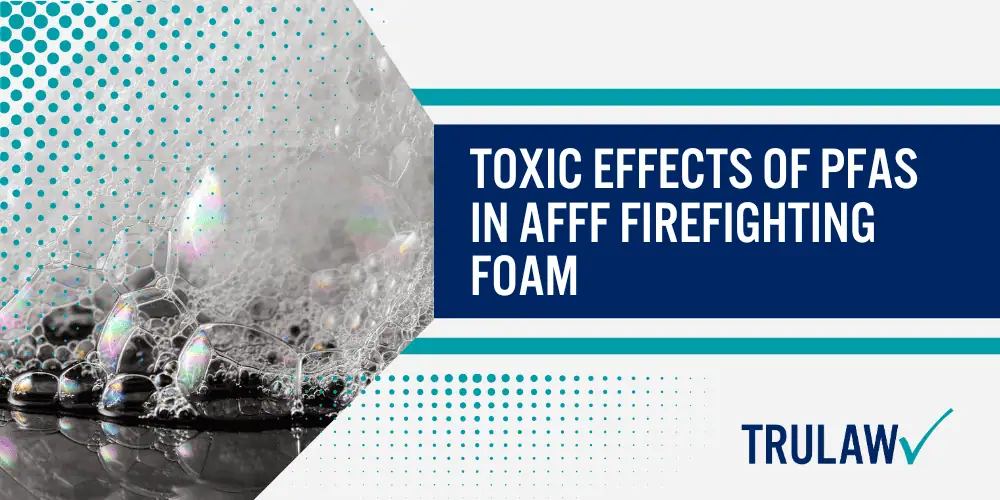
While effective at fighting fires, the PFAS in AFFF can have toxic effects on human health and the environment that have raised serious concerns in recent years.
The Dangers of Forever Chemicals Today
Studies have shown that exposure to certain PFAS may be associated with various adverse health outcomes, although the overall scientific evidence is currently inconclusive.
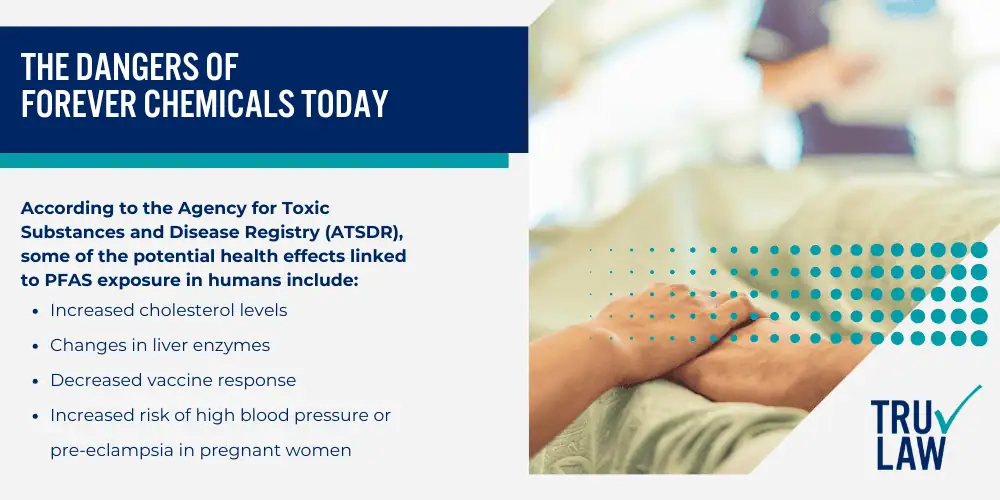
According to the Agency for Toxic Substances and Disease Registry (ATSDR), some of the potential health effects linked to PFAS exposure in humans include:
- Increased cholesterol levels: Some studies suggest PFAS exposure may raise cholesterol levels.
- Changes in liver enzymes: PFAS may cause changes in liver function and enzyme levels.
- Decreased vaccine response: Exposure may reduce antibody responses to vaccines.
- Increased risk of high blood pressure or pre-eclampsia in pregnant women: Some research indicates potential pregnancy-induced hypertension risks.
While these health outcomes have been reported in some studies, more research is still needed to fully understand the link between PFAS exposure and human health effects.
The toxicity of PFAS depends on several factors like the specific chemical, concentration, frequency and duration of exposure.
How PFAS in AFFF Affects the Environment
In addition to potential human health risks, the release of PFAS from AFFF into the environment during firefighting activities is a major concern.
Some key environmental issues include:
- Persistence: PFAS are extremely persistent and do not readily break down in the environment.
- Mobility: These chemicals are highly mobile and can travel long distances in water and air.
- Bioaccumulation: PFAS can accumulate in the bodies of humans and animals over time.
- Contamination: Release of AFFF can contaminate soil, surface water, and groundwater.
Local fire departments are involved in state-led programs aimed at the collection and disposal of fluorinated firefighting foam, working collaboratively with professional firefighting associations to manage significant quantities of unwanted PFAS-containing foam found at fire stations across Wisconsin.
PFAS contamination from the use of AFFF is widespread.
The Department of Defense has identified nearly 700 military sites with known or suspected PFAS releases.
Contaminated groundwater and drinking water supplies in surrounding communities is a significant issue the military is investigating.
With their persistence, mobility and bio-accumulative properties, PFAS from AFFF pose long-term environmental risks that are still being determined.
If you or a loved one were exposed to toxic firefighting foam and subsequently diagnosed with cancer or experiencing serious health risks, you may be eligible to seek compensation.
Contact TruLaw using the chat on this page to receive an instant case evaluation that can determine if you qualify for the AFFF firefighting foam lawsuit today.
Government Actions and Regulations
In light of the mounting evidence regarding the health and environmental risks posed by AFFF, governments worldwide have implemented various regulations to control its use and mitigate its impact.
In the United States, the Environmental Protection Agency (EPA) has set regulations for PFAS levels in drinking water to protect public health.
The Department of Defense (DOD) has also taken action by banning the use of PFAS-containing AFFF in training exercises.
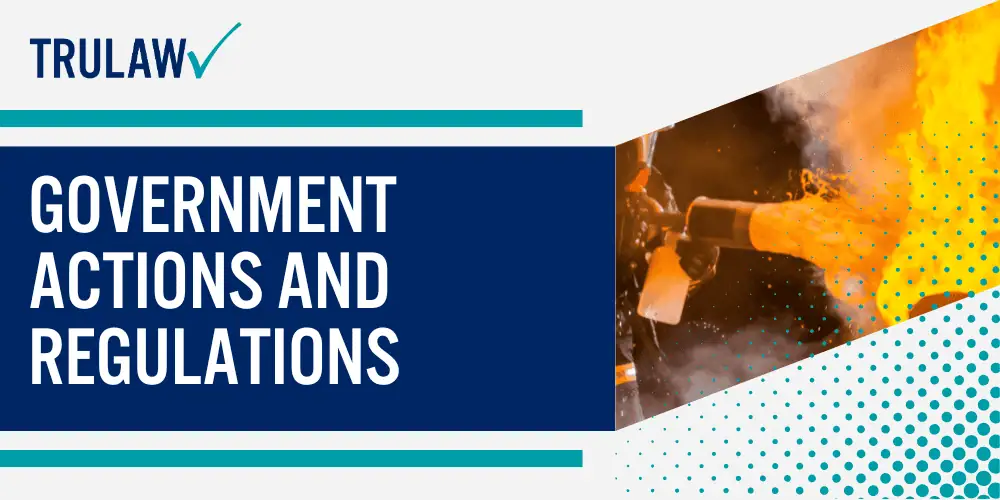
Additionally, the FAA Reauthorization Act of 2018 mandates the FAA to revise its requirements, encouraging airports to transition away from PFAS-containing foams.
Several states have gone further, restricting the use of AFFF for non-federally mandated firefighting and banning its use in training altogether.
Alternatives to AFFF
As concerns over the safety of AFFF have grown, the development of fluorine-free firefighting foams has gained momentum.
These alternatives, made from water, solvents, hydrocarbon surfactant blends, and polysaccharides, offer a safer and more environmentally friendly option for fire suppression.
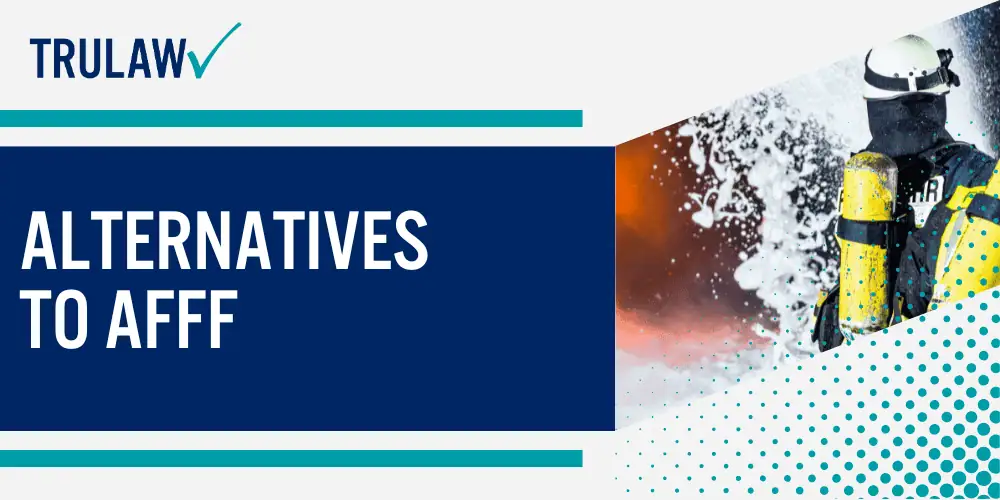
Unlike AFFF, fluorine-free foams are biodegradable and do not contain harmful PFAS chemicals, making them a sustainable choice for fire departments and other organizations.
While some lists of fluorine-free foams are available, it is crucial for firefighting agencies to thoroughly evaluate the validity of these claims to ensure they are using truly safe and effective products.
Cancer Risks Associated with AFFF Exposure
Aqueous Film-Forming Foam (AFFF) and other fire fighting foams have been widely used in firefighting, particularly for extinguishing flammable liquid fires.
However, growing concerns about the toxic chemicals in AFFF—specifically per- and polyfluoroalkyl substances (PFAS)—have linked its use to serious health consequences, including cancer.
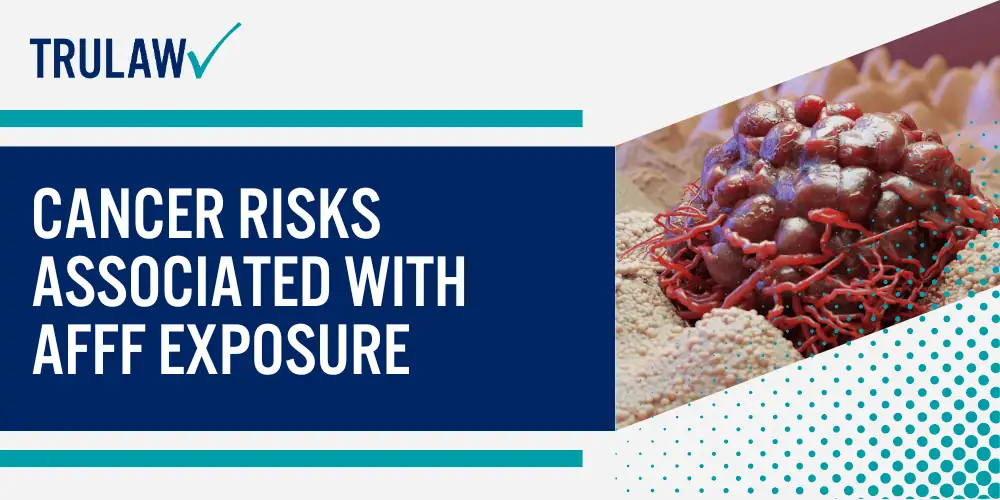
Research suggests prolonged exposure to AFFF may elevate the risk of certain cancers, particularly among individuals in specific occupations or environments.
Understanding these risks is crucial for affected individuals seeking potential legal remedies and compensation.
Cancers Commonly Linked to AFFF
Studies investigating the health impacts of AFFF exposure have identified several cancers that may be associated with prolonged exposure to PFAS.
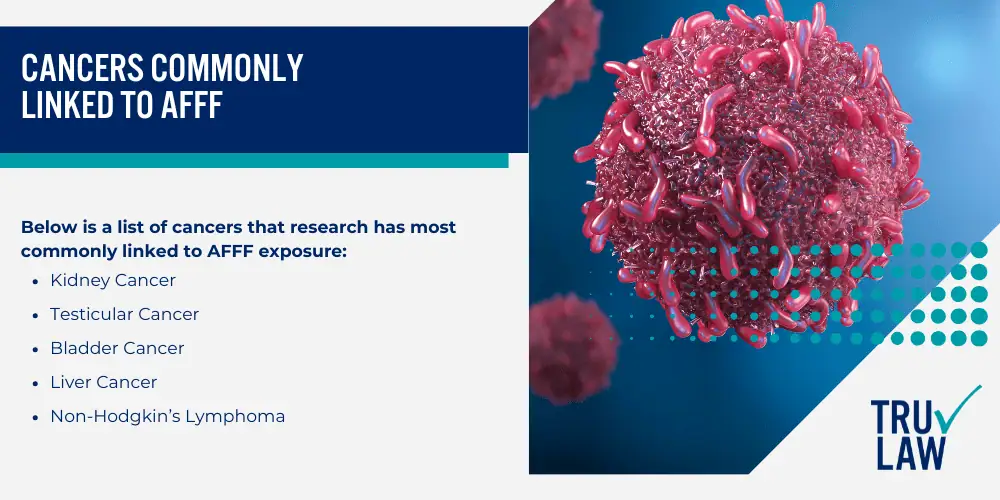
Below is a list of cancers that research has most commonly linked to AFFF exposure:
- Kidney Cancer: Frequently linked to PFAS exposure due to its impact on kidney function and filtration.
- Testicular Cancer: Research has highlighted this as one of the strongest associations with PFAS exposure.
- Bladder Cancer: Prolonged exposure to PFAS can affect the urinary system, elevating bladder cancer risks.
- Liver Cancer: PFAS accumulation in the liver can disrupt metabolic processes, increasing cancer risk.
- Non-Hodgkin’s Lymphoma: PFAS exposure may interfere with the immune system, contributing to the development of this cancer.
These cancers have been documented in numerous epidemiological studies, but the exact risk level depends on the degree and duration of exposure.
If you or a loved one has been diagnosed with any of these cancers following AFFF exposure, you may be eligible for legal action.
Reach out to discuss your case with an experienced attorney.
Occupations with Elevated Cancer Risk from AFFF
Certain occupations face a higher risk of exposure to AFFF, primarily due to frequent and prolonged use in specific settings.
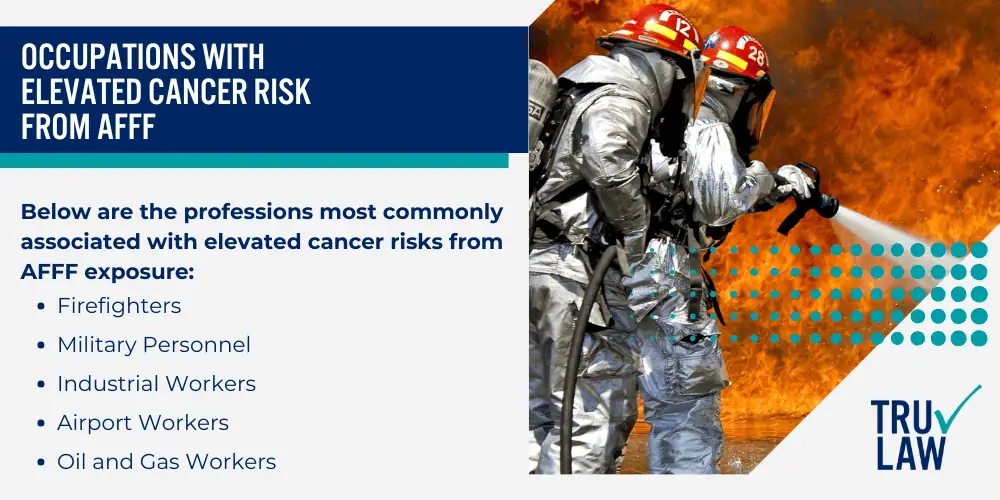
Below are the professions most commonly associated with elevated cancer risks from AFFF exposure:
- Firefighters: Both military and civilian firefighters often use AFFF in training exercises and emergencies, placing them at the highest risk.
- Military Personnel: Those involved in fire suppression at military bases frequently encounter AFFF during drills and operations.
- Industrial Workers: Employees at chemical manufacturing plants or facilities that handle firefighting foam production are at risk of direct exposure.
- Airport Workers: Firefighters and personnel involved in aviation fire safety are often exposed to AFFF through routine fire-safety measures.
- Oil and Gas Workers: Professionals in these industries may encounter AFFF during emergency response scenarios.
Individuals in these professions may face an elevated risk of cancer due to the persistent nature of PFAS chemicals in the body and environment.
If you have worked in any of these roles and suspect AFFF exposure has impacted your health, legal options may be available to you.
If you or a loved one were exposed to toxic firefighting foam and subsequently diagnosed with cancer or experiencing serious health risks, you may be eligible to seek compensation.
Contact TruLaw using the chat on this page to receive an instant case evaluation that can determine if you qualify for the AFFF firefighting foam lawsuit today.
Testing and Diagnosis
Currently, testing for PFAS exposure is not available at VA medical centers, but this is being reconsidered in light of new federal research.
Knowing one’s PFAS blood level can provide reassurance if the levels are normal, but it does not pinpoint the source of exposure or predict future health issues.
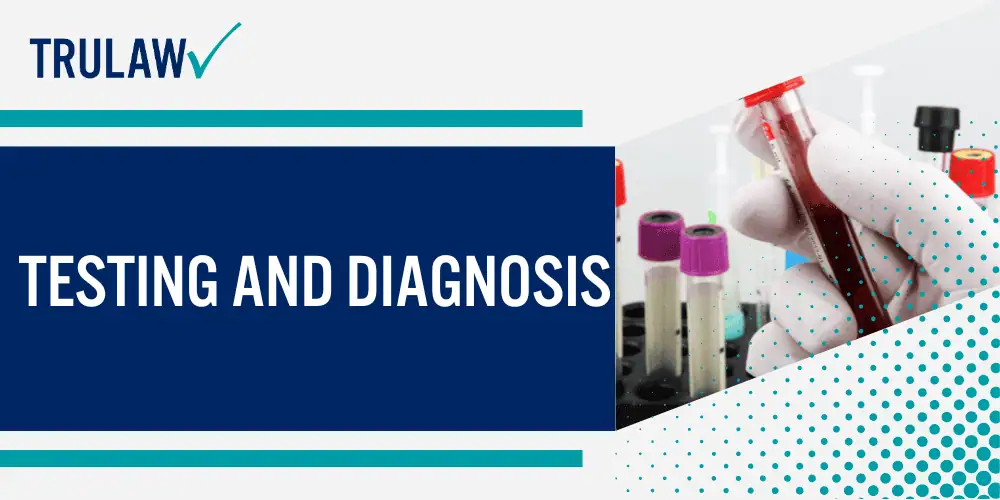
Individuals concerned about health problems related to PFAS exposure during military service should consult their healthcare provider or local VA Environmental Health Coordinator.
Veterans who believe their health issues are linked to chemical exposure during service can file a claim for disability compensation, which will be evaluated on a case-by-case basis.
Filing an AFFF Claim: Determining Liability
Determining liability is an essential part of filing a claim related to Aqueous Film-Forming Foam (AFFF).
The toxic chemicals in AFFF, particularly per- and polyfluoroalkyl substances (PFAS), have led to numerous lawsuits citing severe health and environmental impacts.
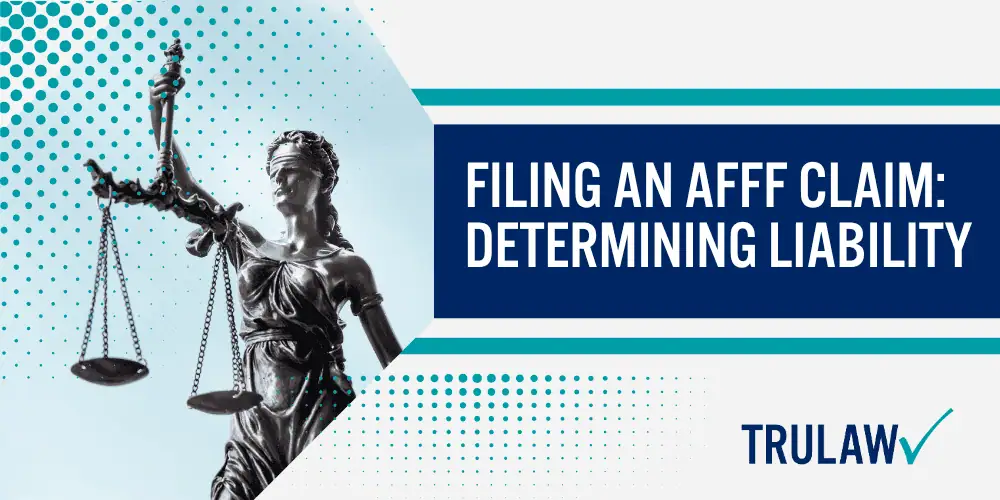
Identifying the responsible parties and understanding the types of claims available are key steps in pursuing compensation.
Identifying Responsible Parties
When pursuing an AFFF claim, it’s important to identify the parties responsible for your exposure or harm.
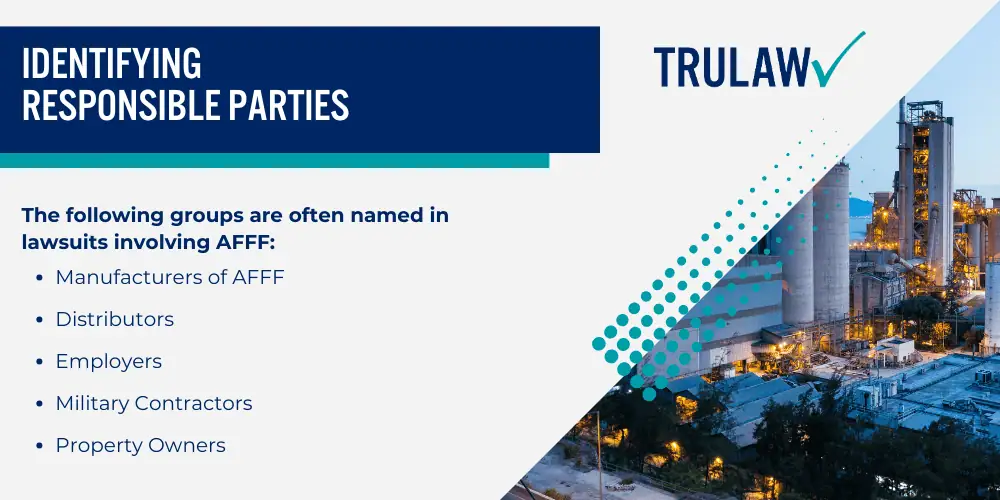
The following groups are often named in lawsuits involving AFFF:
- Manufacturers of AFFF: These companies are frequently held liable for producing and selling products containing harmful PFAS chemicals without sufficient safety warnings.
- Distributors: Entities involved in the distribution of AFFF may share responsibility if they failed to communicate known risks.
- Employers: Employers might be held accountable if they did not provide proper protective equipment or safety protocols for workers handling AFFF.
- Military Contractors: Contractors that supplied AFFF to the military could be liable if they knowingly provided unsafe products or omitted key safety information.
- Property Owners: Facility owners where AFFF was used may face liability for failing to address contamination or inform occupants of exposure risks.
Proving liability often requires showing that these parties either knew or should have known about the dangers of PFAS but failed to take necessary precautions.
A qualified attorney can help investigate and build a strong case.
Different Types of Claims in AFFF Lawsuits
There are several legal avenues available for individuals affected by AFFF exposure.
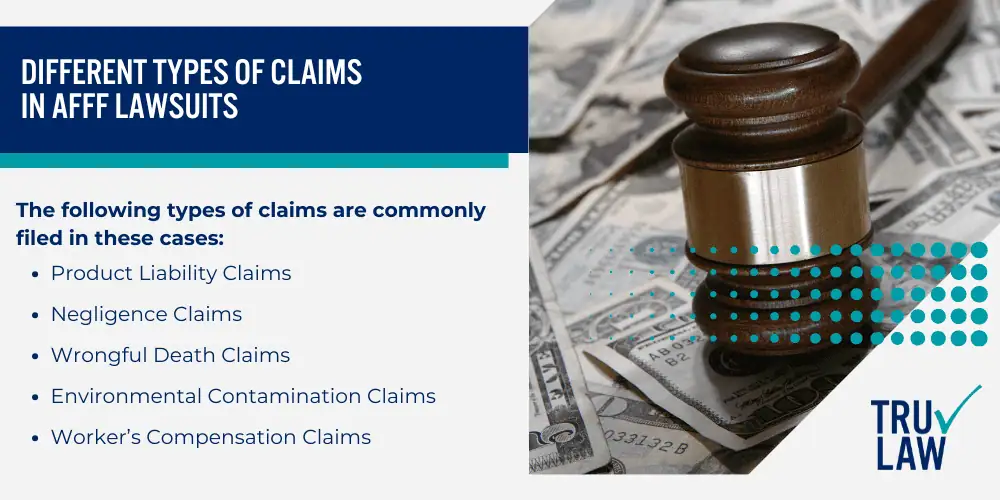
The following types of claims are commonly filed in these cases:
- Product Liability Claims: These claims target manufacturers and suppliers for creating or distributing dangerous products without adequate warnings about PFAS risks.
- Negligence Claims: Plaintiffs may argue that the responsible parties failed to act with reasonable care to prevent exposure to hazardous chemicals.
- Wrongful Death Claims: Families of individuals who died from illnesses linked to AFFF exposure may seek compensation through these claims.
- Environmental Contamination Claims: These claims address widespread pollution caused by AFFF, such as contamination of drinking water or soil.
- Worker’s Compensation Claims: Employees exposed to AFFF in occupational settings may file claims against employers who failed to maintain safe working conditions.
Each type of claim requires specific evidence, including proof of exposure, documentation of damages, and expert testimony linking AFFF to your illness or harm.
An experienced attorney can help you determine which claim best suits your situation and guide you through the legal process.
Filing an AFFF lawsuit can feel overwhelming, but identifying the right claim and holding the responsible parties accountable is an important step toward justice.
If you or a loved one were exposed to toxic firefighting foam and subsequently diagnosed with cancer or experiencing serious health risks, you may be eligible to seek compensation.
Contact TruLaw using the chat on this page to receive an instant case evaluation that can determine if you qualify for the AFFF firefighting foam lawsuit today.
Potential Compensation in AFFF Lawsuit Settlements
While no global settlement has been reached yet in the AFFF firefighting foam lawsuits, plaintiffs can expect varying levels of compensation depending on the severity of their health conditions and extent of exposure.
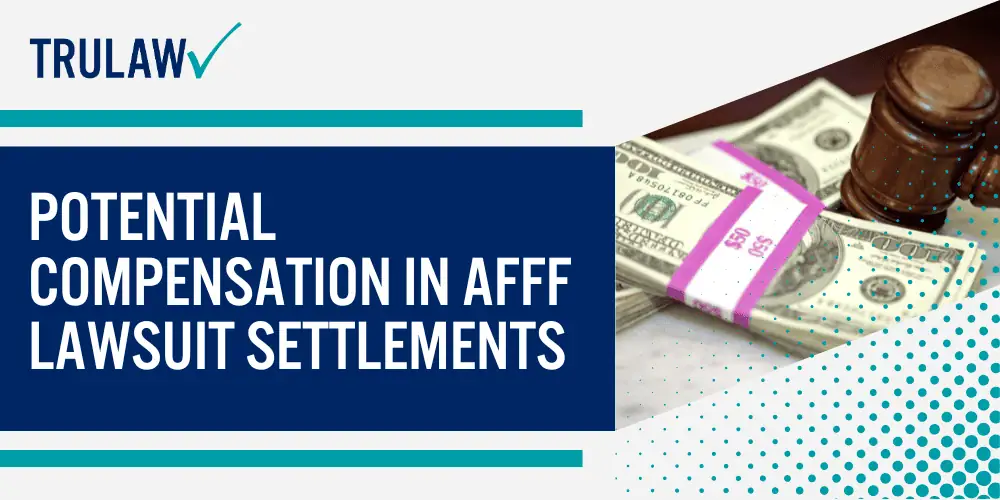
Settlements will likely be tiered, with the most serious cases involving long-term occupational exposure and diagnosis of the most dangerous AFFF-linked cancers, like pancreatic or kidney cancer, receiving the highest payouts.
More moderate cases with less severe cancers or limited exposure would fall into lower settlement tiers.
Types of Expenses Covered in AFFF Settlements
AFFF lawsuit settlements aim to provide compensation for various damages and losses suffered by plaintiffs as a result of their exposure to the toxic chemicals in firefighting foam.
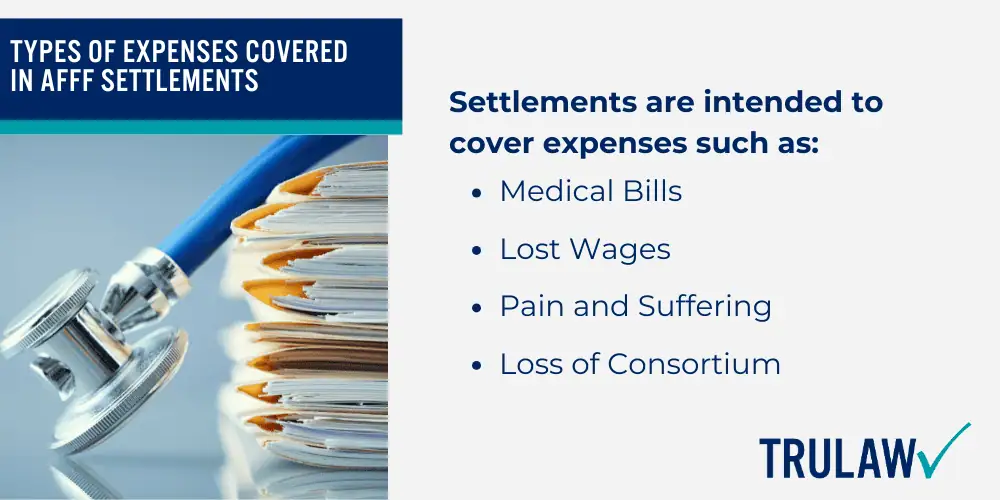
Settlements are intended to cover expenses such as:
- Medical Bills: Costs associated with cancer treatments, hospitalizations, surgeries, medications, and ongoing care
- Lost Wages: Income lost due to inability to work during treatment and recovery
- Pain and Suffering: Physical pain, emotional anguish, and reduced quality of life caused by the illness
- Loss of Consortium: Damages to familial relationships and loss of companionship for spouses
The specific amounts allocated for each category of damages will vary based on the individual circumstances of each case and the severity of the plaintiff’s condition.
However, the goal is to ensure plaintiffs receive adequate compensation to cover their expenses and losses.
Calculating Damages for Pain and Suffering
In addition to economic damages like medical bills and lost wages, AFFF lawsuit settlements also account for non-economic damages such as pain and suffering.
These less tangible losses are evaluated using factors such as:
- Severity of Cancer: More advanced or aggressive cancers warrant higher pain and suffering awards
- Type of Treatment: Invasive surgeries, chemotherapy, and radiation indicate greater physical and emotional anguish
- Disruption to Life: The extent to which the illness has impacted the plaintiff’s ability to work, engage in hobbies, and enjoy life
- Prognosis: Terminal or long-term illnesses result in more pain and suffering than treatable cancers with positive outlooks
Calculating appropriate compensation for pain and suffering is complex and often relies on precedents from prior similar cases.
Experienced attorneys can help plaintiffs determine a fair and reasonable figure to seek in their AFFF lawsuit based on their specific hardships.
The amount awarded for pain and suffering should align with the seriousness of the plaintiff’s condition and the degree to which it has diminished their quality of life.
TruLaw: Your Firefighting Foam Toxic Exposure Law Firm
AFFF firefighting foam lawsuits are being filed by individuals across the country who were exposed to toxic chemicals found in film forming foam AFFF and subsequently developed cancer or other adverse health effects.
TruLaw is currently accepting clients for the AFFF litigation.
A few reasons to choose TruLaw for your AFFF lawsuit include:
- If We Don’t Win, You Don’t Pay: The AFFF attorneys at TruLaw and our partner firms operate on a contingency fee basis, meaning we only get paid if you win.
- Expertise: Our legal team has years of experience handling chemical exposure cases similar to the AFFF litigation, which helps us anticipate what we can expect to see in your case and the regulations we will be required to meet.
- Successful Track Record: TruLaw and our partner law firms have helped our clients recover billions of dollars in compensation through verdicts and negotiated settlements.
If you or a loved one were exposed to toxic firefighting foam and subsequently diagnosed with cancer or experiencing serious health risks, you may be eligible to seek compensation.
Contact TruLaw using the chat on this page to receive an instant case evaluation that can determine if you qualify for the AFFF firefighting foam lawsuit today.
AFFF Lawsuit Frequently Asked Questions
-
AFFF firefighting foam contains harmful PFAS chemicals that have been linked to serious health conditions according to studies since the 1970s.
These toxic chemicals are extremely persistent in the environment and can bioaccumulate in the human body over time.
-
The most common cancers linked to AFFF exposure include kidney cancer, testicular cancer, bladder cancer, liver cancer, and non-Hodgkin’s lymphoma.
The risk level depends on the duration and degree of exposure to these toxic chemicals.
-
Individuals who had occupational exposure as firefighters, military personnel, or airport workers with direct AFFF contact may be eligible for compensation.
They must demonstrate regular exposure through training exercises or emergency response and have a medical diagnosis of specific cancers or conditions linked to PFAS exposure.
-
Major manufacturers including 3M, DuPont, and Tyco Fire Products are facing lawsuits for producing and selling firefighting foam containing dangerous PFAS chemicals.
DuPont has agreed to pay $1.18 billion in settlements, while 3M has committed to a $10.3 billion settlement for water contamination and personal injury claims.
-
PFAS chemicals in AFFF are extremely persistent and do not break down readily in the environment, leading to widespread contamination.
These chemicals can travel long distances in water and air, contaminating soil, surface water, and groundwater supplies around areas where AFFF was used.
-
AFFF lawsuit settlements typically cover medical bills, lost wages, pain and suffering, and loss of consortium.
The compensation amount varies based on factors like severity of illness, type of treatment required, and impact on quality of life.

Managing Attorney & Owner
With over 25 years of legal experience, Jessica Paluch-Hoerman is an Illinois lawyer, a CPA, and a mother of three. She spent the first decade of her career working as an international tax attorney at Deloitte.
In 2009, Jessie co-founded her own law firm with her husband – which has scaled to over 30 employees since its conception.
In 2016, Jessie founded TruLaw, which allows her to collaborate with attorneys and legal experts across the United States on a daily basis. This hypervaluable network of experts is what enables her to share the most reliable, accurate, and up-to-date legal information with our readers!
Additional AFFF Lawsuit resources on our website:
Here, at TruLaw, we’re committed to helping victims get the justice they deserve.
Alongside our partner law firms, we have successfully collected over $3 Billion in verdicts and settlements on behalf of injured individuals.
Would you like our help?
At TruLaw, we fiercely combat corporations that endanger individuals’ well-being. If you’ve suffered injuries and believe these well-funded entities should be held accountable, we’re here for you.
With TruLaw, you gain access to successful and seasoned lawyers who maximize your chances of success. Our lawyers invest in you—they do not receive a dime until your lawsuit reaches a successful resolution!
AFFF Lawsuit claims are being filed against manufacturers of aqueous film-forming foam (AFFF), commonly used in firefighting.
Claims allege that companies such as 3M, DuPont, and Tyco Fire Products failed to adequately warn users about the potential dangers of AFFF exposure — including increased risks of various cancers and diseases.
Depo Provera Lawsuit claims are being filed by individuals who allege they developed meningioma (a type of brain tumor) after receiving Depo-Provera birth control injections.
A 2024 study found that women using Depo-Provera for at least 1 year are five times more likely to develop meningioma brain tumors compared to those not using the drug.
Suboxone Tooth Decay Lawsuit claims are being filed against Indivior, the manufacturer of Suboxone, a medication used to treat opioid addiction.
Claims allege that Indivior failed to adequately warn users about the potential dangers of severe tooth decay and dental injuries associated with Suboxone’s sublingual film version.
Social Media Harm Lawsuits are being filed against social media companies for allegedly causing mental health issues in children and teens.
Claims allege that companies like Meta, Google, ByteDance, and Snap designed addictive platforms that led to anxiety, depression, and other mental health issues without adequately warning users or parents.
Transvaginal Mesh Lawsuits are being filed against manufacturers of transvaginal mesh products used to treat pelvic organ prolapse (POP) and stress urinary incontinence (SUI).
Claims allege that companies like Ethicon, C.R. Bard, and Boston Scientific failed to adequately warn about potential dangers — including erosion, pain, and infection.
Bair Hugger Warming Blanket Lawsuits involve claims against 3M — alleging their surgical warming blankets caused severe infections and complications (particularly in hip and knee replacement surgeries).
Plaintiffs claim 3M failed to warn about potential risks — despite knowing about increased risk of deep joint infections since 2011.
Baby Formula NEC Lawsuit claims are being filed against manufacturers of cow’s milk-based baby formula products.
Claims allege that companies like Abbott Laboratories (Similac) and Mead Johnson & Company (Enfamil) failed to warn about the increased risk of necrotizing enterocolitis (NEC) in premature infants.
Here, at TruLaw, we’re committed to helping victims get the justice they deserve.
Alongside our partner law firms, we have successfully collected over $3 Billion in verdicts and settlements on behalf of injured individuals.
Would you like our help?
